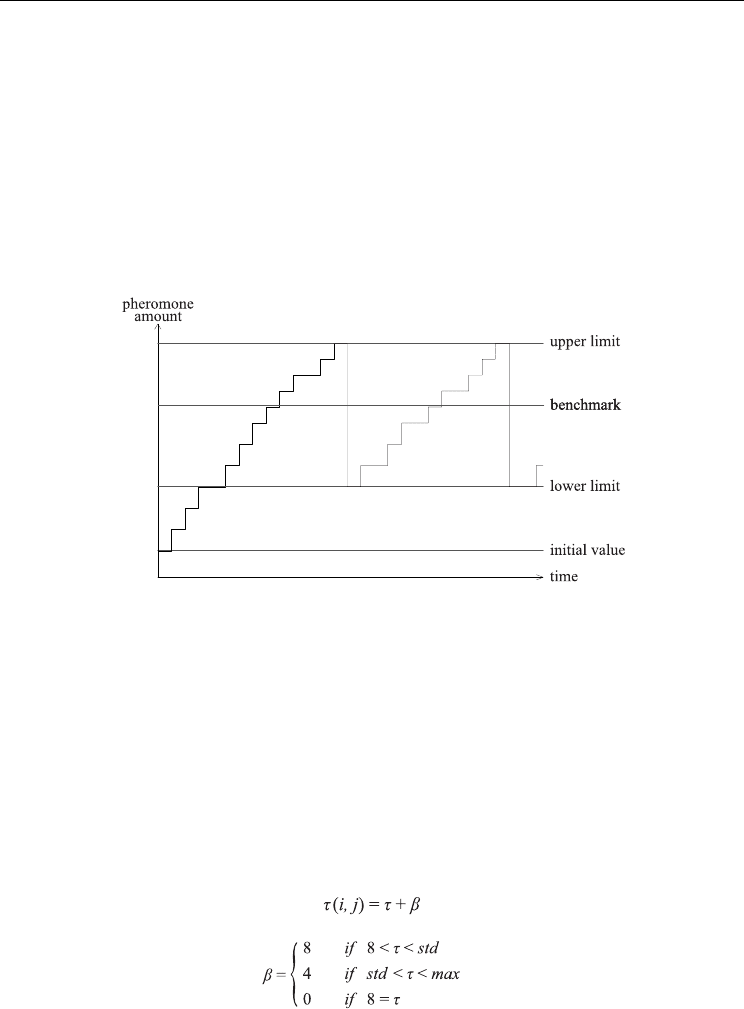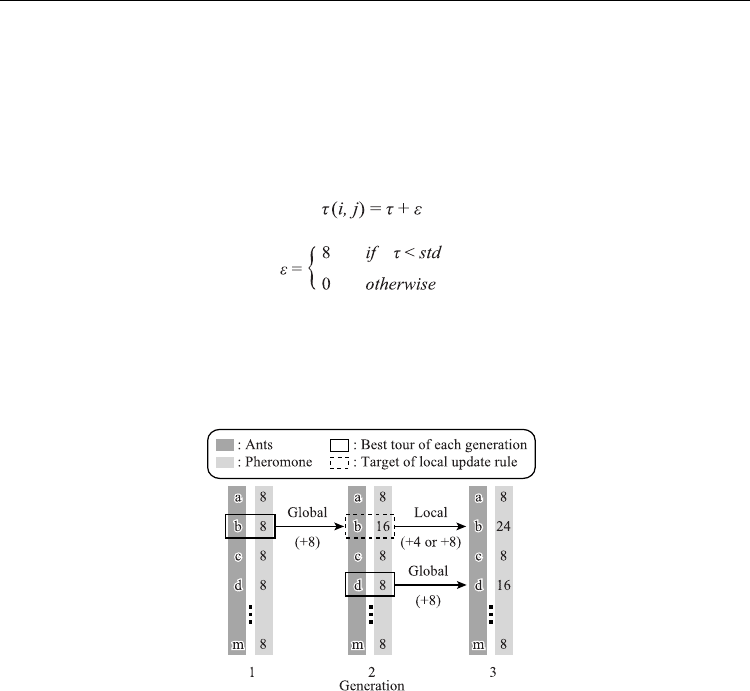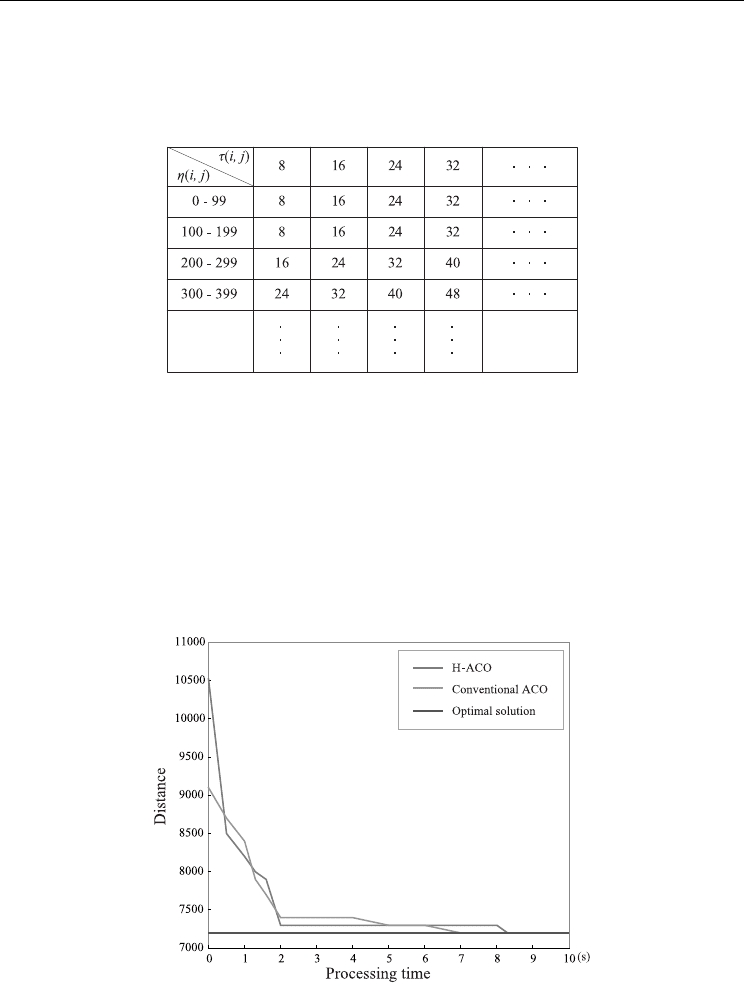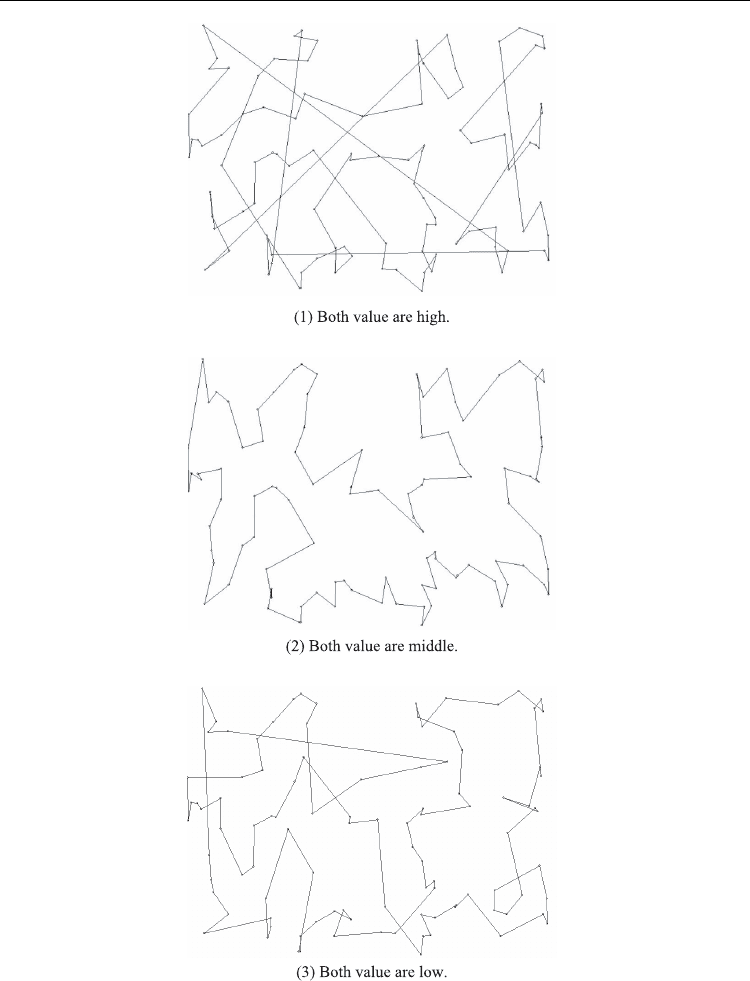Bednorz W. (ed.) Advances in Greedy Algorithms
Подождите немного. Документ загружается.


Hardware-oriented Ant Colony Optimization Considering Intensification and Diversification
361
Thus, no studies have ever seen, to our knowledge, the hardware oriented ACO algorithm
which does not utilize floating point arithmetic.
3. Hardware-oriented ACO
3.1 Pheromone update rule
In the H-ACO, in order to control the trade-off between intensification (exploitation of the
previous solutions) and diversification (exploration of the search space), upper and lower
limits are set in a manner similar to the Max-Min AS. Here, a new benchmark of the
pheromone is also introduced. Using this benchmark, an increment of the pheromone is
determined. An example in which the pheromone is added is shown in Fig.1, where the
horizontal axis indicates the time and the vertical axis indicates the pheromone value.
Fig. 1. Example of transition of pheromone
The pheromone value (pheromone amount) is added by performing the search starting from
the initial value
τ
0. When the pheromone value is smaller than the benchmark, a large
number of the pheromones are added from a viewpoint of intensification.
On the other hand, when the pheromone value is larger than the benchmark, a small
number of pheromones are added to diversify the search space.
When a particular tour (route) has a large number of pheromones, this indicates that the
tour is often selected. When the pheromone value reached the upper limit, the pheromone
value is reduced to the lower limit. By this operation, the probability of other tours being
selected is increased from a viewpoint of diversification. In other words, the H-ACO is
controlled to perform a global search in this case.
A new equation (4) is introduced to the local update rule and it is defined as follows.
(4)
Where, std represents the benchmark, max is upper limit, and the initial value of pheromone
(
τ
0) is set to 8. In the local update rule, if
τ
(i,j) = 8, the increment is 0, i.e., no local update will

Advances in Greedy Algorithms
362
be performed. In other words, trapping by a local optimal solution can be avoided without
adding excessive pheromones to the tour at early stages of the search.
Moreover, high-speed processing can be also realized by reducing the number of processing
steps. For example, when the numbers of ants (agents) and cities are denoted as m and n,
respectively, the number of processing steps required for the local update rule of m × n
times can be reduced in the first search.
The global update rule is defined by the equation (5).
(5)
As regards the global update rule, if it is applied only when the pheromone value is smaller
than the benchmark, a larger global search can be performed.
Fig. 2 shows an example in which the local and global update rules are applied. As shown in
the figure, the local update rule is only performed to the tours that pheromone have been
added to in the global update rule.
Fig. 2. Example of local update rule and global update rule
That is, in the H-ACO, a global search is performed at the early stage of search, and a local
search is performed as the search progressed. Thus, H-ACO can achieve not only speed-up
of the pheromone update procedure by reducing the number of processing steps, but also
effective search by controlling of intensification and diversification.
3.2 Selection method using Look-Up-Table technique
In the general ACO, when the city of the next destination is selected, a power calculation, as
shown in equation (1), is required. In addition, the heuristics value, as the information
peculiar to a certain problem, is a decimal because it is the reciprocal of distance. Therefore,
when the heuristics value is realized in a dedicated hardware, a floating point arithmetic
unit is required. To simplify hardware resources, the number of processing steps and the
control, however, power calculations and floating point arithmetic operations are not
suitable for the hardware.
In the H-ACO, a selection technique based on the LUT system is introduced. As the
heuristics value, the value that is obtained by converting the reciprocal of distance to the

Hardware-oriented Ant Colony Optimization Considering Intensification and Diversification
363
positive integer is used. As the pheromone value, only the values that are multiples of 4, as
shown in the equation (4) and (5) of the pheromone update rule, are used. Then, the LUT,
into which both the heuristics and pheromone values are input, is created. Fig.3 shows an
example of the LUT. By using the integral value and the LUT system, it ensures that all the
operations can be performed by simple addition, subtraction, and shift operations.
Fig. 3. Example of Look-Up-Table
4. Experiments and discussion
In order to verify the validity of the H-ACO, several comparative experiments are
conducted. First, in order to evaluate search performance, the H-ACO is compared with the
conventional ACO described in Section 2. 1. The experimental platform is a Pentium 4 3.0
GHz and the program is described by the C language. As experimental data, the original
data from 50 cities, in which the optimal solution is already known, and the travelling
salesman problem library (TSP.LIB) benchmark data of 100 cities are used. The experimental
results are shown in Figs. 4 and 5.
Fig. 4. Result of 50 cities
In both figures, the horizontal axis indicates the processing time and the vertical axis
indicates the total distance of the route. As shown in both figures, the search performance of

Advances in Greedy Algorithms
364
the H-ACO, which does not use decimal operation and power calculation, is similar to that
of the conventional ACO, which does require their use.
Next, an experiment to evaluate the controllability of parameters is conducted. In the
conventional ACO, the balance of the pheromone value and the heuristics value is
controlled by parameter
β
in the equation (1) and the balance of the information on the past
behaviour and that on the new behavior is controlled by decay parameters
ψ
and
ρ
(the
evaporation rate) in the equations (2) and (3).
In the H-ACO, the LUT value, upper limit, lower limit, and benchmark are used as the
parameters, instead of parameters
ψ
,
ρ
and
β
, to control these balances.
The experimental results with various LUT values are shown in Fig. 6. Fig.6 (1) shows the
result of setting the pheromone value larger than the heuristics value.
Fig. 5. Result of 100 cities
Fig.6. (3) shows the result when the pheromone value is set to be smaller than the heuristics
value.
As shown in Fig.6 (1), since the influence of the heuristics value (in this case, it is the
distance between the cities) is small, this search is similar to a random search and many
tours are intersected.
As shown in Fig.6 (3), since the influence of the distance between the cities is great, the
cities (the distance between which is small) are selected in the initial stage of the route
construction; that is, a behavior similar to the greedy algorithm is observed. Therefore, in
the final stage, to complete the route, cities with large distances between them are
selected.
As shown in Fig.6 (2), the pheromone value and the heuristics value are well-balanced, and
an effective search is realized. Thus, the technique of using the LUT value, which has been
newly introduced to the H-ACO, instead of parameter β and power calculation, which are
used in the conventional ACO, is clearly shown to provide an effective selection of the cities
with well-balanced pheromone and heuristics values.

Hardware-oriented Ant Colony Optimization Considering Intensification and Diversification
365
Fig. 6. Result of several kinds of LUTs
Fig. 7 shows the results of the experiments in which various upper limits and benchmarks of
the pheromone value are used.

Advances in Greedy Algorithms
366
Fig. 7. Result of several pairs of upper limit and benchmark
In these experiments, since the relative relationship between the upper limit and the
benchmark is considered as maintained even if the lower limit is fixed, only the upper limit

Hardware-oriented Ant Colony Optimization Considering Intensification and Diversification
367
and the benchmark are changed. Figs.7 (1), (3), and (2) show the results of the experiments,
in which the upper limit and the benchmark are set to be high, low, and intermediate,
respectively.
As shown in Fig.7 (1), since the upper limit was set high, pheromone is accumulated over a
long period. This means that, since the past information is considered important, no
progress is observed in the search.
As shown in Fig.7 (3), since the distance between the upper limit and the benchmark is small
due to the low upper limit, this search is similar to a random search.
In contrast, as shown in Fig.7 (2), when the upper limit and the benchmark are well-
balanced, a satisfactory solution is obtained.
Thus, simply by adjusting the upper limit and the benchmark, the same effect as using the
decay parameters, which controlled the information on the past behavior and the
information on the new behavior, can be realized. Based on the above experimental results,
the proposed H-ACO is confirmed to provide a similar solution searching mechanism and
ability as seen with the conventional ACO, without the need for floating point arithmetic
operations and power calculations.
5. Conclusion
In this chapter, we proposed a novel hardware-oriented ACO algorithm. The proposed
algorithm introduced new pheromone update rules using the LUT. It enabled all
calculations for optimization with only addition, subtraction, and shift operation. Moreover,
it controlled the trade-off between exploitation of the previous solutions and exploration of
the search space effectively. As a result, the proposed algorithm achieved not only high
speed processing, but also maintenance of the quality of solutions. Experiments using
benchmark data proved effectiveness of the proposed algorithm.
6. References
Dorigo, M., Maniezzo, V. & Colorni,A.(1996). Ant system: optimization by a colony of
cooperating agents, IEEE Transactions on Systems, Man and Cybernetics, Part B,
Vol.26, No.1,pp.29-41.
Dorigo, M. & Gambardella, L.M.(1997). Ant colony system: a cooperative learning approach
to the traveling salesman problem, IEEE Transactions on Evolutionary Computation,
Vol.1, No.1, pp.53-66.
Frye, R.C., Rietman, E.A. & Wong, C.C. (1991). Back-propagation learning and nonidealities
in analog neural network hardware, IEEE Transactions on Neural Networks, Vol.2,
No.1, pp.110-117.
Haibin, D. & Xiufen, Y. (2007). Progresses and Challenges of Ant Colony Optimization-
Based Evolvable Hardware, Proceedings of IEEE Workshop on Evolvable and Adaptive
Hardware, pp.67-71.
Imai, T., Yoshikawa, M., Terai, H. & Yamauchi, H. (2002).Scalable GA-Processor
Architecture and Its Implementation of Processor Element, Proceedings of IEEE
International Conference on Acoustics, Speech, and Signal Processing, Vol.3, pp.3148-
3151.

Advances in Greedy Algorithms
368
Luo, R. & Sun, P.(2007). A Novel Ant Colony Optimization Based Temperature-Aware
Floorplanning Algorithm, Proceedings of Third International Conference on Natural
Computation, Vol.4, pp.751-755.
Nakano, M., Iida, M. & Sueyoshi, T. (2006). An Implementation of Ant Colony Optimization
for the MaTriX Processing Engine, Proceedings of IEICE-RECONF2006-27, Vol.106,
No.247,pp.1-6.
Ramkumar, A.S. & Ponnambalam, S.G. (2006). Hybrid Ant colony System for solving
Quadratic Assignment Formulation of Machine Layout Problems, Proceedings of
IEEE Conference on Cybernetics and Intelligent Systems, pp.1-5.
Sankar, S.S., Ponnambalam, S.G., Rathinavel, V. & Visveshvaren, M.S. (2005). Scheduling in
parallel machine shop: an ant colony optimization approach, Proceedings of IEEE
International Conference on Industrial Technology, pp.276-280.
Scott, S.D., Samal, A. & Seth, S. (1995). HGA:A Hardware-Based Genetic Algorithm,
Proceedings of Iternational Symposium on Field-Programmable Gate Array, pp.53-59.
Yoshikawa, M. & Terai,H. (2007). Architecture for high-speed Ant Colony Optimization,
Proceedings of IEEE International Conference on Information Reuse and Integration,
pp.95-100.
20
Heuristic Algorithms for Solving Bounded
Diameter Minimum Spanning Tree Problem and
Its Application to
Genetic Algorithm Development
Nguyen Duc Nghia and Huynh Thi Thanh Binh
Ha Noi University of Technology
Viet Nam
1. Introduction
The bounded diameter minimum spanning tree (BDMST) problem is a combinatorial
optimization problem that appears in many applications such as wire-based communication
network design when certain aspects of quality of service have to be considered, in ad-hoc
wireless network (K. Bala, K. Petropoulos, T.E. Sterm, 1993) and in the areas of data
compression and distributed mutual exclusion algorithms (K. Raymond, 1989; A. Bookstein,
S. T. Klein, 1996). A more comprehensive discussion of the real-world applications of
BDMST was given in Abdalla’s seminal dissertation (Abdalla, 2001).
Before the BDMST problem can be formally stated, we need some definitions relating to tree
diameter and center. Given a tree T, the maximal eccentricity of vertex v is the length
(measured in the number of edges) of the longest path from v to other vertices. The diameter
of a tree T, denoted as diam(T), is the maximal eccentricity over all nodes in T (i.e the length
of maximal path between two arbitrary vertices in T). Suppose that a diameter of a tree is
defined by the path v
0
, v
1
, v
2
,…, v
[k/2]
, v
[k/2]+1
, …, v
k
. If k is even then v
[k/2]
is called a center of
the tree. If k is odd then v
[k/2]
and v
[k/2]+1
are centers of the tree. In that case, the edge (v
[k/2]
,
v
[k/2]+1
) is called a center edge.
Let G = (V, E) be a connected undirected graph with positive edge weights w(e). The BDMST
problem can be formulated as follows: among spanning trees of G whose diameters do not
exceed a given upper bound k ≥ 2, find the spanning tree with the minimal cost (sum of the
weights on edges of the trees). As in almost all studies of the BDMST problem, and without
lost of generality, we will assume that G is a complete graph.
More precisely, the problem can be stated as:
Find a spanning tree T of G that minimizes
() ()
eT
WT we
∈
=
∑
subject to
diam(T) ≤ k .

Advances in Greedy Algorithms
370
This problem is known to be NP-hard for 4 ≤ k < |V|-1 (M.R.Garey & D.S.Johnson, 1979).
In this chapter, we introduce the heuristic algorithms for solving BDMST: OTTC (Abdall,
2001), RGH (R.Raidl & B.A.Julstrom, 2003), RGH
1
(Binh et.at, 2008a), RGH-I (A. Singh & A.K.
Gupta, 2007), CBRC (Binh et al., 2008b). In order to inlustrate the effectiveness of the
proposed algorithms, we apply them for initializing the population of our new genetic
algorithm with multi-parent recombination operator for solving given problem. Then results
of computational experiments are reported to show the efficiency of proposed algorithms.
The chapter is organized as follows. In the next section (section 2), we briefly overview
works done in solving BDMST problems. Section 3 deals with new heuristic algorithm for
solving BDMST problem. Section 4 describes our new genetic algorithm which uses
heuristic algorithms that already presented in previous section to solve BDMST problem.
The details of experiments and the comparative computational results are given and
discussed in the last section of the chapter.
2. Previous work on the BDMST problem
Techniques for solving the BDMST problem may be classified into two categories: exact
methods and inexact (heuristic) methods. Exact approaches for solving the BDMST problem
are based on mixed linear integer programming (N.R.Achuthan et al., 1994), (L Gouveia et
al., 2004). More recently, Gruber and Raidl suggested a branch and cut algorithm based on
compact 0-1 integer linear programming (M. Gruber & G.R. Raidl, 2005). However, being
deterministic and exhaustive in nature, these approaches could only be used to solve small
problem instances (e.g. complete graphs with less than 100 nodes).
(Abdalla et al., 2000) presented a greedy heuristic algorithm - the One Time Tree
Construction (OTTC) for solving the BDMST problem. OTTC is based on Prim’s algorithm
in (R. Prim, 1957). It starts with a set of vertices, initially containing a randomly chosen
vertex. The set is then repeatedly extended by adding a new vertex that is nearest (in cost) to
the set, as long as the inclusion of the new node does not violate the constraint on the
diameter of the tree. This algorithm is time consuming, and its performance is strongly
dependent on the starting vertex.
Raidl and Julstrom proposed in (G.R. Raidl & B.A. Julstrom, 2003) a modified version of
OTTC, called Randomized Greedy Heuristics (RGH). RGH starts from a centre by randomly
selecting a vertex and keeping it as the fixed center during the search. It then repeatedly
extends the spanning tree from the center by adding a randomly chosen vertex from the
remaining vertices, and connecting it to a vertex that is already in the tree via an edge with
the smallest weight. The obtained results showed that on Euclidean instances RGH performs
better than OTTC, whereas on non-Euclidean instances the situation is reversed.
RGH could be summarized in the following pseudo-code (G.R. Raidl & B.A. Julstrom, 2003)
T ← ∅;
U ← V;
v0 ← random(U);
U ← V − {v0};
C ← {v0};
depth[v0] ← 0;
if (odd(k)) {
v1 ← random(U);
